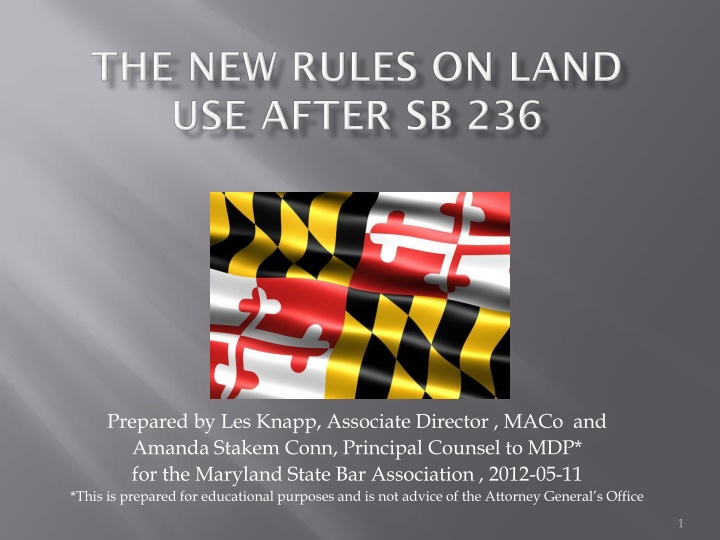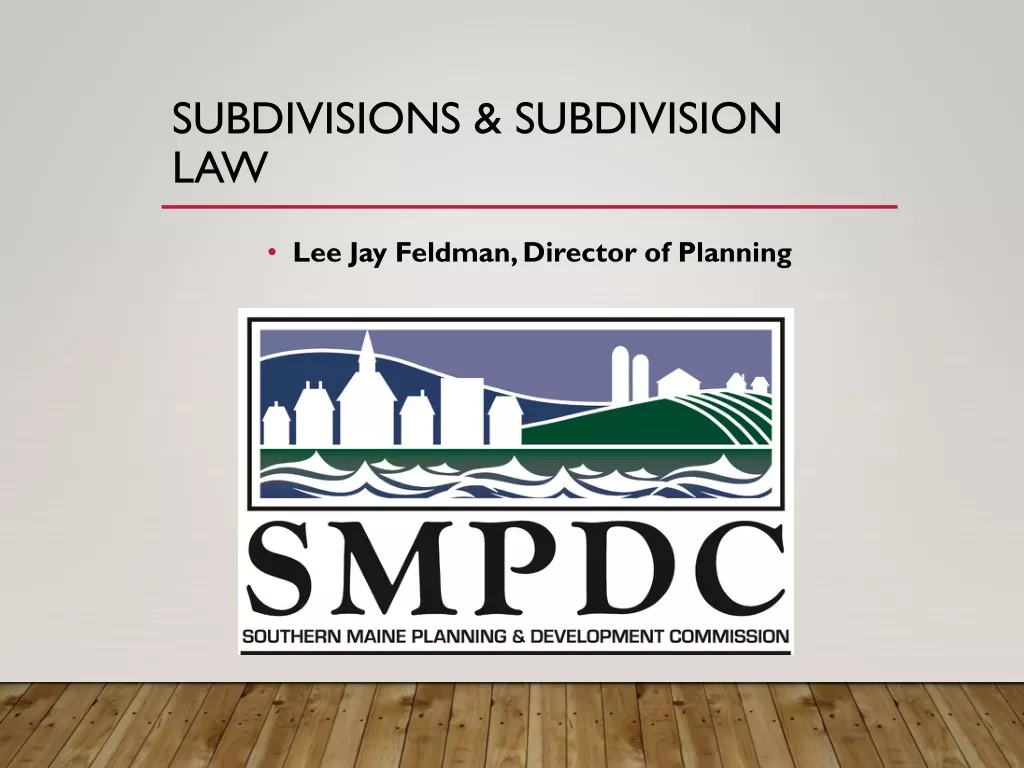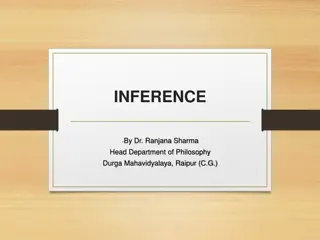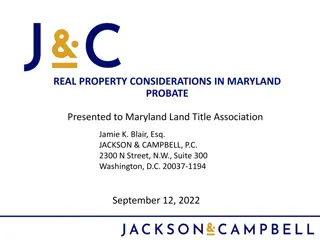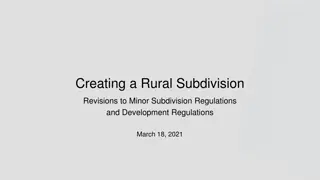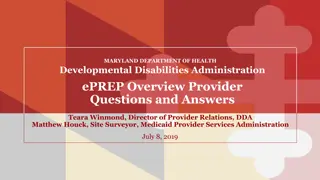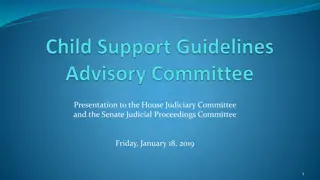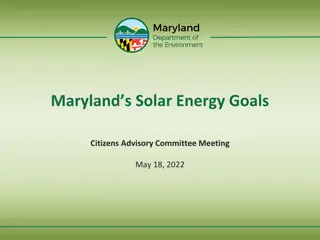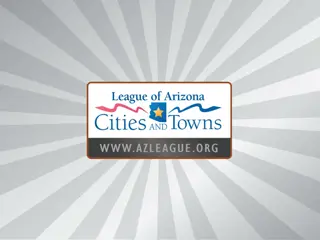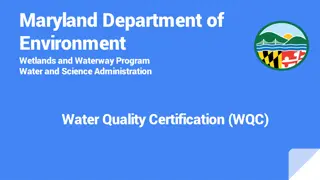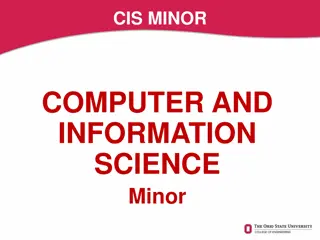Regulations on Major and Minor Subdivisions in Maryland
This document outlines the definitions and regulations surrounding major and minor subdivisions in Maryland, specifically related to growth tiers, exemptions, reporting requirements, and adoption processes by local jurisdictions. It explains the optional adoption of growth tiers, restrictions on residential developments served by different sewer systems, and the requirements for documenting and submitting proposed tiers to the Maryland Department of Planning for review.
Download Presentation

Please find below an Image/Link to download the presentation.
The content on the website is provided AS IS for your information and personal use only. It may not be sold, licensed, or shared on other websites without obtaining consent from the author.If you encounter any issues during the download, it is possible that the publisher has removed the file from their server.
You are allowed to download the files provided on this website for personal or commercial use, subject to the condition that they are used lawfully. All files are the property of their respective owners.
The content on the website is provided AS IS for your information and personal use only. It may not be sold, licensed, or shared on other websites without obtaining consent from the author.
E N D
Presentation Transcript
Prepared by Les Knapp, Associate Director , MACo and Amanda Stakem Conn, Principal Counsel to MDP* for the Maryland State Bar Association , 2012-05-11 *This is prepared for educational purposes and is not advice of the Attorney General s Office 1
Major/Minor Subdivision Definitions Definition of Tiers Tier Development and Adoption Tier Check by Maryland Department of the Environment (MDE) Exemption Provisions Grandfathering Reporting Requirements 2
Local Jurisdictions may adopt a definition of major and minor residential subdivisions for the purposes of the bill by Dec. 31, 2012. New definitions of minor subdivisions may not exceed 7 new lots 3
Adoption of Growth Tiers by a local jurisdiction is optional After December 31, 2012, a local jurisdiction that has not adopted Tiers cannot authorize major residential subdivisions served by septic systems, community sewerage systems, or shared systems. May only authorize residential minor subdivisions served by septic systems or a major or minor subdivision served by public sewer. Tier adoption process and statutory criteria for the Tiers is located in Article 66B (and after Oct. 1, Title 1, Subtitle 5 of the Land Use Article). Tier development prohibitions and limits is located in 9-206 of the Environment Article. Four classes of Tiers (I-IV) that dictate whether residential development may occur on a public sewerage system or a septic system 4
A local jurisdiction does not have to adopt all 4 Tiers. Counties must adopt Tiers I, III, and IV and may adopt Tier II. Municipalities must adopt Tier I and may adopt Tier II. If a local jurisdiction does not adopt all of the authorized Tiers, the local jurisdiction must document the reasons for not adopting a particular Tier. Local jurisdictions may use their existing comprehensive plan and zoning ordinance to create the Tiers [Uncodified Section 4 of SB 236] Before adopting the Tiers, a local jurisdiction may submit proposed Tiers to Maryland Department of Planning (MDP) for technical assistance, review, and comment After adoption of the Tiers, a local jurisdiction shall provide a map and information to MDP demonstrating the location of the Tiers and existing or planned water and sewer services 5
MDP may comment on the Tiers adopted by a local jurisdiction. If MDP comments, then the local legislative body or planning board/commission must hold a public hearing and review the tiers based on the comments. If the planning board/commission holds the hearing, it must recommend to the local legislative body whether the Tiers should be changed or remain as adopted. The local jurisdiction is not bound to the recommendations of MDP 6
A local jurisdiction that adopts the Tiers must incorporate the Tiers into its local comprehensive plan or an element of the plan when the local jurisdiction conducts its 6-year review of the plan. A local jurisdiction may adopt the Tiers as an amendment to its comprehensive plan and may include the Tiers as an appendix that delineates the Tiers and the comprehensive plan land use categories and zoning ordinance districts that are included in each Tier. [Uncodified Section 4 of SB 236] 7
A Tier I area must: (1) be a mapped locally designated growth area served by public sewerage OR (2) a municipal corporation that is a priority funding area (PFA) and served by public sewerage 9
Tier I allows: (1) major and minor subdivisions on public sewerage 10
A Tier II area must: (1) be planned to be served by a public sewerage in a municipal growth element or a mapped locally designated growth area AND (2) be needed to satisfy the demand for development at densities consistent with the jurisdiction s long-term development policy after considering the capacity of land areas available for development, including in-fill and redevelopment 11
Tier II allows: (1) major or minor subdivisions on public sewerage systems (2) minor subdivisions on septic systems 12
A Tier III area must: (1) not be planned for sewerage service (2) not be dominated by agricultural or forest land (3) not be planned or zoned by a local government for land, agricultural, or resource protection AND (4) fall in one of the following categories a municipal corporation not served by public sewerage a rural village as defined by statute ( 5-7B-03(f) of the State Finance and Procurement Article) an area planned or zoned for large lot development a mapped locally designated growth area NOTE: A local jurisdiction must strive to avoid creating a Tier III area that is bounded on all sides by land in a Tier IV area. 13
Tier III allows: (1) minor subdivisions on septic systems (2) major subdivisions on septic systems, community systems, or shared facilities if the local planning board has reviewed and recommended the approval of the major subdivision NOTE: Before approving a Tier III major subdivision the planning board must hold at least one public hearing and include as part of its review: (1) the cost of providing local government services to the subdivision (unless such review is already required); and (2) the potential environmental issues or a natural resources inventory related to the proposed subdivision) 14
A Tier IV areas cannot be planned for sewerage service and are: (1) areas planned or zoned by a local jurisdiction for land, agricultural, or resource protection, preservation, or conservation (2) areas dominated by agricultural lands, forest lands, or other natural areas OR (3) Rural Legacy areas, priority preservation areas, or areas subject to a State or local covenant, restriction, condition, or conservation easement for the purposes of natural resources or agricultural land preservation 15
Tier IV allows: (1) minor subdivisions on septic systems (2) IF the jurisdiction s Tier IV area has been verified by MDP as having an actual overall yield of not more than one dwelling unit per 20 acres, major subdivisions on septic systems, community systems, or shared facilities at the local jurisdiction s discretion 16
For exception to apply, a local jurisdiction may request that MDP verify that the jurisdiction s subdivision and zoning requirements in the jurisdiction s cumulative Tier IV area result in an actual overall yield of not more than one dwelling unit per 20 acres If requested by a local jurisdiction to verify, MDP shall: (1) review the local zoning code and any relevant subdivision or development regulations or rules to help determine the overall development yield; (2) request, if appropriate, information from the local jurisdiction to help determine the overall development yield in Tier IV; (3) examine any additional information that the local jurisdiction provides supporting the qualification of the jurisdiction s zoning districts; (4) consult with the Maryland Sustainable Growth Commission; and (5) discuss any discrepancies or questions with the local jurisdiction before making a final determination [ 9-206(h) of the Environment Article and Uncodified Section 5 of SB 236] 17
If two or more local jurisdictions adopt conflicting Tier designations for the same area, the Department of the Environment (MDE) and MDP shall confer with the local jurisdictions to seek resolution. If the conflict is not resolved, MDE shall determine which Tier designation prevails MDP shall recommend to MDE a preferred Tier designation based on: (1) The local jurisdictions comprehensive plans, including applicable municipal growth elements, water resource elements, land use elements, and priority preservation elements; (2) Growth projections and development capacity; AND (3) Availability of infrastructure MDE may accept MDP s recommendation or substitute its own decision when making a decision on which Tier designation prevails 18
Bill contains provisions that prevent land from being subdivided into minor subdivisions on septics overtime if the land is located in a Tier that is restricted to minor subdivisions on septic Exceptions to the resubdivision restriction: Subdividing into one subdivision over time is allowed; and When land becomes a PFA that is to be served by public sewer 19
July 1, 2012 effective date Final plat approval by December 31, 2012 Limitations on wastewater disposal systems do not apply No final plat approval by December 31, 2012: (1) Do grandfather provisions apply; or (2) If not, limitations on wastewater disposal systems apply
On or before February 1st, 2013 MDP, in consultation with MDE, shall report on: adoption of the tiers by each local jurisdiction adoption or alteration of local ordinances or regs to implement the Act list of comments that MDP provided to each jurisdiction 21
Public hearings on MDP comments Recommended date for Tier Adoption MDP Planning Directors Meeting 10/1/12 12/31/12 2012-2013 5/24/12 7/1/12 Feb 2013 Effective Date of Bill If no tiers adopted, restrictions on major subdivisions in place; - adopt new definition of subdivision MDP report due to General Assembly http://www.waronruralmaryland.com/wp-content/uploads/2011/06/Bay-Bridge.jpg
Impact will vary based on local jurisdiction Little impact for municipalities and Baltimore City Moderate impact on urban counties and counties close to their build-out capacity Significant impact on some rural counties 23
Local government responsibility Flexibility in Tier designation Growth in rural areas SB 236 does not exist in a vacuum 24
2006 New water resources element, municipal growth element, and priority preservation element [HB 1141 and HB 2] 2007 New stormwater management requirements [HB 786/SB 784] 2008 New critical area requirements [HB 1253] 2009 New planning visions, Smart Growth measures and indicators, and plan consistency requirements [HB 294/SB 273, HB 295/SB 276, and HB 297/SB 280] 2010 New transportation planning requirements [HB 1155] 2011 PlanMaryland [Executive Order 01.01.2011.22] 2012 New Growth Tiers and septic system restrictions [SB 236] The Present Chesapeake Bay Total Maximum Daily Load requirements The Future Greenhouse gas reduction initiatives 25
SB 236 has teeth and will limit future development on septic systems Local governments are expected to designate Tiers responsibly but also should be afforded a level of flexibility when designating the Tiers.* Effect of SB 236 is further magnified when considered as part of cumulative package of recent land use and environmental initiatives As land use and environmental laws and regulations become increasingly complex, Maryland land use attorneys will not suffer a shortage of work *Amanda Conn notes that the Tiers must meet the requirements of Article 66B. 26
